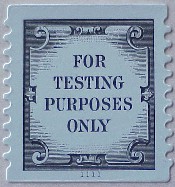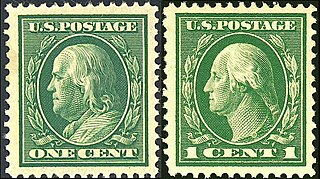
A postage stamp is a small piece of paper issued by a post office, postal administration, or other authorized vendors to customers who pay postage. Then the stamp is affixed to the face or address-side of any item of mail—an envelope or other postal cover —which they wish to send. The item is then processed by the postal system, where a postmark or cancellation mark—in modern usage indicating date and point of origin of mailing—is applied to the stamp and its left and right sides to prevent its reuse. Next the item is delivered to its addressee.

Stamp collecting is the collecting of postage stamps and related objects. It is an area of philately, which is the study of stamps. It has been one of the world's most popular hobbies since the late nineteenth century with the rapid growth of the postal service, as a stream of new stamps was produced by countries that sought to advertise their distinctiveness through their stamps.

For postage stamps, separation is the means by which individual stamps are made easily detachable from each other.

Postal service in the United States began with the delivery of stampless letters whose cost was borne by the receiving person, later encompassed pre-paid letters carried by private mail carriers and provisional post offices, and culminated in a system of universal prepayment that required all letters to bear nationally issued adhesive postage stamps.

A definitive stamp is a postage stamp that is part of the regular issue of a country's stamps, available for sale by the post office for an extended period of time and designed to serve the everyday postal needs of the country. The term is used in contrast to a "provisional stamp", one that is issued for a temporary period until regular stamps are available, or a "commemorative stamp", a stamp "issued to honor a person or mark a special event" available only for a limited time. Commonly, a definitive issue or series includes stamps in a range of denominations sufficient to cover current postal rates. An "issue" generally means a set that is put on sale all at the same time, while a "series" is spread out over several years, but the terms are not precise. Additional stamps in a series may be produced as needed by changes in postal rates; nevertheless some values may be permanently available, regardless of prevailing rates; examples include 1c or 1p and $1 or £1.
This is a list of philatelic topics.

A training stamp is a label resembling a postage stamp that is used by postal authorities to train postal workers. They generally have the same size and shape as regular stamps, but with a minimal design. Alternatively, several countries have simply obliterated their regular stamps in order to make the training process more realistic, for instance Sudan and the United Kingdom.

A postage stamp booklet is a booklet made up of one or more small panes of postage stamps in a cardboard cover. Booklets are often made from sheets especially printed for this purpose, with a narrow selvage at one side of the booklet pane for binding. From the cutting, the panes are usually imperforate on the edges of the booklet. Smaller and easier to handle than a whole sheet of stamps, in many countries booklets have become a favored way to purchase stamps.

A coil stamp is a type of postage stamp sold in strips one stamp wide. The name derives from the usual handling of long strips, which is to coil them into rolls, in a manner reminiscent of adhesive tape rolls. A large percentage of modern stamps are sold in coil form, because they are more amenable to mechanized handling in large quantities than either sheet stamps or booklet stamps.

The Machin series of postage stamps was the main definitive stamp series in the United Kingdom for most of the reign of Elizabeth II, from 1967 until her death in 2022. Introduced on 5 June 1967, it was the second series of her reign, replacing the Wilding series. The last issue was on 4 April 2022, four months before the Queen's death on 8 September.

The postage stamps of Ireland are issued by the postal operator of the independent Irish state. Ireland was part of the United Kingdom of Great Britain and Ireland when the world's first postage stamps were issued in 1840. These stamps, and all subsequent British issues, were used throughout Ireland until the new Irish Government assumed power in 1922. Beginning on 17 February 1922, existing British stamps were overprinted with Irish text to provide some definitives until separate Irish issues became available within the new Irish Free State. Following the overprints, a regular series of definitive stamps was produced by the new Department of Posts and Telegraphs, using domestic designs. These definitives were issued on 6 December 1922, the day that the Irish Free State officially came into existence; the first was a 2d stamp, depicting a map of Ireland. Since then new images, and additional values as needed, have produced nine definitive series of different designs.

A dummy stamp is a stamp-like label which is not valid for postal use. Dummy stamps are a form of cinderella stamp and the two principal types are test or training stamps, used to test postal equipment or train postal workers, and printer's sample stamps created to promote or demonstrate the printing capabilities of a stamp printer.

In general, philatelic fakes and forgeries are labels that look like postage stamps but have been produced to deceive or defraud. Learning to identify these can be a challenging branch of philately.

A stamp vending machine (SVM) is a mechanical, electrical or electro-mechanical device which can be used to automatically vend postage stamps to users in exchange for a pre-determined amount of money, normally in coin. Most SVMs were positioned in public places to provide a useful service to customers when other sources of postage stamps, such as Post Offices were closed. The term is often applied to the entire object as found attached to a pillar box or sited in a wall. The name Stamp Vending Machine only applies to the internal mechanism, the housing is described by the UK Post Office as a "case" and was supplied, installed and maintained separately. Many postal administrations around the world have used automatic stamp vending machines including the United States, where private manufacturers began vending stamps from coils in 1908. Most countries of the Commonwealth of Nations have issued stamps for use in Stamp Vending Machines, including Hong Kong, New Zealand and Malta.

Definitive postage stamps of Ireland are the regular series of definitive postage stamps issued by the Irish Free State between 1922 and 1937 and by Republic of Ireland since 1937. Nine distinctly different series of designs have been released; additionally the watermark was changed for two issues and the currency was changed on three occasions while the designs remained the same.

Postage stamps of Pakistan are those issued since Pakistan's independence in 1947. Pakistan Post has issued more than 600 sets and singles totalling more than 1300 stamps. Immediately after the independence of Pakistan in 1947, the new Pakistan government was preoccupied with setting up the government so British Indian stamps continued in use without an overprint as was the practice in other countries.

The Washington–Franklin Issues are a series of definitive U.S. Postage stamps depicting George Washington and Benjamin Franklin, issued by the U.S. Post Office between 1908 and 1922. The distinctive feature of this issue is that it employs only two engraved heads set in ovals—Washington and Franklin in full profile—and replicates one or another of these portraits on every stamp denomination in the series. This is a significant departure from previous definitive issues, which had featured pantheons of famous Americans, with each portrait-image confined to a single denomination. At the same time, this break with the recent past represented a return to origins. Washington and Franklin, after all, had appeared on the first two American stamps, issued in 1847, and during the next fifteen years, each of the eight stamp denominations available featured either Washington or Franklin.

The Regular Issues of 1922–1931 were a series of 27 U.S. postage stamps issued for general everyday use by the U.S. Post Office. Unlike the definitives previously in use, which presented only a Washington or Franklin image, each of these definitive stamps depicted a different president or other subject, with Washington and Franklin each confined to a single denomination. The series not only restored the historical tradition of honoring multiple presidents on U.S. Postage but extended it. Offering the customary presidential portraits of the martyred Lincoln and Garfield, the war hero Grant, and the founding fathers Washington and Jefferson, the series also memorialized some of the more recently deceased presidents, beginning with Hayes, McKinley, Cleveland and Roosevelt. Later, the deaths of Harding, Wilson and Taft all prompted additions to the presidential roster of Regular Issue stamps, and Benjamin Harrison's demise (1901) was belatedly deemed recent enough to be acknowledged as well, even though it had already been recognized in the Series of 1902. The Regular Issues also included other notable Americans, such as Martha Washington and Nathan Hale—and, moreover, was the first definitive series since 1869 to offer iconic American pictorial images: these included the Statue of Liberty, the Capitol Building and others. The first time (1869) that images other than portraits of statesmen had been featured on U.S. postage, the general public disapproved, complaining that the scenes were no substitute for images of presidents and Franklin. However, with the release of these 1922 regular issues, the various scenes—which included the Statue of Liberty, the Lincoln Memorial and even an engraving of an American Buffalo—prompted no objections. To be sure, this series presented pictorial images only on the higher-value stamps; the more commonly used denominations, of 12 cents and lower, still offered the traditional portraits.

The Series of 1902, also known as the Second Bureau Issue, is a set of definitive postage stamps in fourteen denominations ranging between one cent and five dollars, produced by the U. S. Bureau of Engraving and Printing and issued by the United States Post Office. Two denominations appeared in November and December 1902 and the other twelve were released between January and June 1903. These stamps were assigned the Scott Catalogue numbers 300 through 313. Also considered part of the series is a fifteenth stamp which appeared in November 1903—a second version of the 2¢ value, the original having faced severe criticism. This series, particularly noted for its exceptional ornateness and opulence of design, remained in circulation until late 1908, when it was superseded by the Washington-Franklin Issues.

A Horizon label is an adhesive postage label that is a type of variable value stamp. The labels were introduced in the United Kingdom in 2002 as part of the computerisation of the counter services of the post office network of Royal Mail using the Horizon System.


















